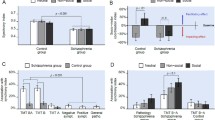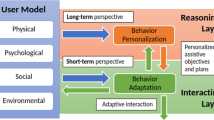Abstract
The goal of this study was to analyze the interpersonal coordination of patients suffering from schizophrenia (SZ) using a humanoid robot NAO. NAO was controlled by a neurally-inspired model that enables motions synchronization between robot and human. Using a robot has the advantage in that it can be modified and controlled without being influenced by the human with whom they are interacting. More specifically, we were interested in non-intentional interpersonal coordination which has been found in previous studies to be preserved for SZ. We performed an experiment in which we asked patients and control participants to jointly perform fitness movements with the robot which was programmed to either synchronize with the human (a bidirectional condition) or move at a fixed frequency with them (a unidirectional condition). We showed that non-intentional interpersonal coordination was preserved for SZ during Human/Robot interaction (as for human/human interaction). Also, the best synchronization, stability and the best performance in term of speed were obtained with the bidirectional condition. Our results showed that, in this specific context of an interaction at preferential frequency of subject, there were only a few differences between SZ and controls in terms of interpersonal synchronization skills. Nevertheless, we observed more variability for SZ which could partly be explained by the weaker intrapersonal coordination that they exhibited.














Similar content being viewed by others
Data Availability Statement
Not available.
Code availability
Statistical analyses were performed with Jamovi software (The jamovi project (2020), jamovi (Version 1.1.9) for Windows).
References
Alahbabi M, Almazroei F, Almarzoqi M, Almeheri A, Alkabi M, Nuaimi AA, Cappuccio M, Alnajjar F (2017) Avatar based interaction therapy: a potential therapeutic approach for children with autism. In: 2017 IEEE international conference on mechatronics and automation (ICMA), pp 480–484. https://doi.org/10.1109/ICMA.2017.8015864
Amazeen P, Schmidt R, Turvey MT (1995) Frequency detuning of the phase entrainment dynamics of visually coupled rhythmic movements. Biol Cybern. https://doi.org/10.1007/BF00199893
Anzalone S, Tanet A, Pallanca O, Cohen D, Chetouani M (2016) A humanoid robot controlled by neurofeedback to reinforce attention in autism spectrum disorder. In: Proceedings of the 3rd Italian workshop on artificial intelligence and robotics. https://hal.sorbonne-universite.fr/hal-02422951
Argyle M, Salter V, Nicholson H, Williams M, Burgess P (1970) The communication of inferior and superior attitudes by verbal and non-verbal signals. Br J Soc Clin Psychol. https://doi.org/10.1111/j.2044-8260.1970.tb00668.x
Barakova EI, Bajracharya P, Willemsen M, Lourens T, Huskens B (2014) Long-term lego therapy with humanoid robot for children with asd. Expert Syst. https://doi.org/10.1111/exsy.12098
Chartrand LT, Bargh JA (1999) The chameleon effect: the perception-behavior link and social interaction. J Pers Soc Psychol. https://doi.org/10.1037//0022-3514.76.6.893
Ciolacu MV (2014) Facial expressions and non verbal communication. Procedia Soc Behav Sci. https://doi.org/10.1016/j.sbspro.2014.03.372
Cohen L, Khoramshahi M, Salesse RN, Bortolon C, Słowiński P, Krasimira Tsaneva-Atanasova CZ, Bernardo MD, Ludovic Marin DC, Schmidt RC, Bardy BG, Billard A, Raffard S (2017) Influence of facial feedback during a cooperative human-robot task in schizophrenia. Sci Rep. https://doi.org/10.1038/s41598-017-14773-3
Davalos DB, Kisley MA, Ross RG (2003) Effects of interval duration on temporal processing in schizophrenia. Brain Cogn. https://doi.org/10.1016/s0278-2626(03)00157-x
Degnan A, Berry K, Sweet D, Abel K, Crossley N, Edge D (2018) Social networks and symptomatic and functional outcomes in schizophrenia: a systematic review and meta-analysis. Soc Psychiatry Psychiatr Epidemiol. https://doi.org/10.1007/s00127-018-1552-8
Del-Monte J, Capdevielle D, Varlet M, Marin L, Schmidt R, Salesse R, Bardy B, Boulenger JP, Gély-Nargeot MC, Attal J, Raffard S (2013) Social motor coordination in unaffected relatives of schizophrenia patients: a potential intermediate phenotype. Front Behav Neurosci. https://doi.org/10.3389/fnbeh.2013.00137
Del-Monte J, Raffard S, Salesse RN, Marin L, Schmidt RC, Varlet M, Bardy BG, Boulenger JP, Gély-Nargeot MC, Capdevielle D (2013) Nonverbal expressive behaviour in schizophrenia and social phobia. Psychiatry Res. https://doi.org/10.1016/j.psychres.2013.05.034
de Rugy A, Salesse R, Oullier O, Temprado JJ (2006) A neuro-mechanical model for interpersonal coordination. Biol Cybern. https://doi.org/10.1007/s00422-006-0059-7
Dodell-Feder D, Tully LM, Hooker CI (2015) Social impairment in schizophrenia: new approaches for treating a persistent problem. Curr Opin Psychiatry. https://doi.org/10.1097/YCO.0000000000000154
Elvevag B, McCormack T, Gilbert A, Brown GDA, Weinberger DR, Goldberg TE (2003) Duration judgements in patients with schizophrenia. Psychol Med. https://doi.org/10.1017/s0033291703008122
Freitas H, Costa P, Silva V, da Silva Pereira AP, Soares F, Esteves JS (2017) Using a humanoid robot as the promoter of the interaction with children in the context of educational games. Int J Mechatron Appl Mech
Green MF, Horan WP, Lee J (2015) Social cognition in schizophrenia. Nat Rev Neurosci. https://doi.org/10.1038/nrn4005
Green MF, Kern RS, Braff DL, Mintz J (2000) Neurocognitive deficits and functional outcome in schizophrenia: are we measuring the “right stuff”? Schizophr Bull. https://doi.org/10.1093/oxfordjournals.schbul.a033430
Feasibility of collaborative learning and work between robots and children with autism spectrum disorders. Lecture Notes in Computer Science, vol 10091. Springer, Cham (2017). https://doi.org/10.1007/978-3-319-50953-2_32
Hasnain SK, Mostafaoui G, Gaussier P (2012) A synchrony-based perspective for partner selection and attentional mechanism in human–robot interaction. Paladyn J Behav Robot. https://doi.org/10.2478/s13230-013-0111-y
Hasnain SK, Mostafaoui G, Salesse R, Marin L, Gaussier P (2013) Intuitive human robot interaction based on unintentional synchrony: a psycho-experimental study. https://doi.org/10.1109/DevLrn.2013.6652569
Henkel V, Mergl R, Schäfer M, Rujescu D, Möller H, Hegerl U (2004) Kinematical analysis of motor function in schizophrenic patients: a possibility to separate negative symptoms from extrapyramidal dysfunction induced by neuroleptics? Pharmacopsychiatry. https://doi.org/10.1055/s-2004-818988
Horn KPB, Schunck GB (1981) Determining optical flow. Artif Intell 17(1):185–203
Issartel J, Marin L, Cadopi M (2007) Unintended interpersonal co-ordination: “can we march to the beat of our own drum?”. Neurosci Lett. https://doi.org/10.1016/j.neulet.2006.09.086
Lavelle M, Healey P, McCabe R (2013) Is nonverbal communication disrupted in interactions involving patients with schizophrenia? Schizophr Bull. https://doi.org/10.1093/schbul/sbs091
Lavelle M, Healey PG, McCabe R (2014) Nonverbal behavior during face-to-face social interaction in schizophrenia: a review. J Nerv Ment Dis. https://doi.org/10.1097/NMD.0000000000000031
Levit-Binnun N, Handzy NZ, Moses E, Modai I, Peled A (2007) Transcranial magnetic stimulation at m1 disrupts cognitive networks in schizophrenia. Schizophr Res. https://doi.org/10.1016/j.schres.2007.02.019
Maxwell SE, Delaney HD (1990) Designing experiments and analyzing data: a model comparison perspective. Routledge, New York. https://doi.org/10.2307/2532173
Usefulness of animal type robot assisted therapy for autism spectrum disorder in the child and adolescent psychiatric ward. Lecture Notes in Computer Science, vol 10091. Springer, Cham (2017). https://doi.org/10.1007/978-3-319-50953-2_35
Mittal VA, Neumann C, Saczawa M, Walker EF (2008) Longitudinal progression of movement abnormalities in relation to psychotic symptoms in adolescents at high risk of schizophrenia. Arch Gen Psychiatry. https://doi.org/10.1001/archgenpsychiatry.2007.23
Morrison RL, Bellack AS (1987) Social functioning of schizophrenic patients: clinical and research issues. Schizophr Bull. https://doi.org/10.1093/schbul/13.4.715
Rae I, Takayama L, Mutlu B (2013) In-body experiences: embodiment, control, and trust in robot-mediated communication. In: Proceedings of the 2013 ACM annual conference on human factors in computing systems. https://doi.org/10.1145/2470654.2466253
Raffard S, Salesse R, Catherine Bortolo BGB, Henriques J, Marin L, Stricker D, Capdevielle D (2018) Using mimicry of body movements by a virtual agent to increase synchronization behavior and rapport in individuals with schizophrenia. Sci Rep. https://doi.org/10.1038/s41598-018-35813-6
Revel A, Andry P (2009) Emergence of structured interactions: from theoretical model to pragmatic robotics. Neural Netw. https://doi.org/10.1016/j.neunet.2009.01.005
Robot-assisted training of joint attention skills in children diagnosed with autism. Lecture Notes in Computer Science, vol 9388. Springer, Cham (2015). https://doi.org/10.1007/978-3-319-25554-5_30
Schmidt R, O’Brien B (1997) Evaluating the dynamics of unintended interpersonal coordination. Ecol Psychol. https://doi.org/10.1207/s15326969eco0903_2
Schmidt RC, Richardson MJ (2008) Dynamics of interpersonal coordination. Chap. Understanding complex systems. Springer. https://doi.org/10.1007/978-3-540-74479-5_14
Shamsuddin S, Yussof H, Ismail LI, Mohamed S, Hanapiah FA, Zaharid NI (2012) Humanoid robot nao interacting with autistic children of moderately impaired intelligence to augment communication skills. Procedia Engineering 41:1533–1538. https://doi.org/10.1016/j.proeng.2012.07.346
Silva S, Soares F, Costa S, Pereira AP, Moreira F (2012) Development of skills in children with asd using a robotic platform. In: 2012 IEEE 2nd Portuguese meeting in bioengineering (ENBENG), pp. 1–4. https://doi.org/10.1109/ENBENG.2012.6331347
So W, Wong M, Cabibihan J, Lam C, Chan R, Qian H (2016) Using robot animation to promote gestural skills in children with autism spectrum disorders. J Comput Assist Learn. https://doi.org/10.1111/jcal.12159
Tennyson M, Kuester DA, Casteel J, Nikolopoulos C (2016) Accessible robots for improving social skills of individuals with autism. J Artif Intell Soft Comput Res. https://doi.org/10.1515/jaiscr-2016-0020
Tiruneh G (2009) The relationship between physical activity and body mass index: issues in model specification. Nat Precedings. https://doi.org/10.1038/npre.2009.2758.4
Turrell YND, Thomas P, Giersch A (2006) Attention for movement production: abnormal profiles in schizophrenia. Schizophr Res. https://doi.org/10.1016/j.schres.2006.02.013
Varlet M, Stephane Raffard LM, Schmidt R, Capdevielle D, Boulenger J, Del-Monte J, Bardy B (2012) Impairments of social motor coordination in schizophrenia. PLoS ONE. https://doi.org/10.1371/journal.pone.0029772
Vicaria I, Dickens L (2016) Meta-analyses of the intra- and interpersonal outcomes of interpersonal coordination. J Nonverbal Behav. https://doi.org/10.1007/s10919-016-0238-8
Zheng Z, Young EM, Swanson AR, Weitlauf AS, Warren ZE, Sarkar N (2016) Robot-mediated imitation skill training for children with autism. IEEE Trans Neural Syst Rehabil Eng. https://doi.org/10.1109/TNSRE.2015.2475724
Acknowledgements
This work was supported by local grant (Clinical research funding from CHU Montpellier), CNRS RHIAPS Project and DGA (Direction Générale des Armées)
Funding
This work was funding by local grant (Clinical research funding from CHU Montpellier), CNRS RHIAPS Project and DGA (Direction Générale des Armées).
Author information
Authors and Affiliations
Corresponding author
Ethics declarations
Conflict of interest
The authors declare that they have no conflicts of interest.
Additional information
Publisher's Note
Springer Nature remains neutral with regard to jurisdictional claims in published maps and institutional affiliations.
Rights and permissions
About this article
Cite this article
Aubin, L., Mostafaoui, G., Amiel, C. et al. Study of Coordination Between Patients with Schizophrenia and Socially Assistive Robot During Physical Activity. Int J of Soc Robotics 13, 1625–1640 (2021). https://doi.org/10.1007/s12369-021-00750-4
Accepted:
Published:
Issue Date:
DOI: https://doi.org/10.1007/s12369-021-00750-4




